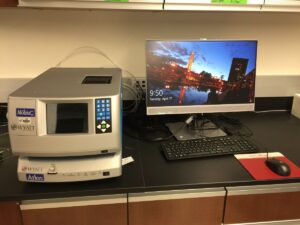
The Mobius is the finest, most versatile light scattering instrument for reliable electrophoretic mobility and size measurements of proteins, polymers, and all types of nanoparticles.
Massively parallel phase analysis light scattering
The Mobius characterizes the mobility of proteins and other biomolecules non-destructively, thanks to an innovative design that incorporates 32 parallel detectors denoted as ‘massively parallel phase analysis light scattering’, or MP-PALS.
MP-PALS is a true enabler for maximum sensitivity and short acquisition times. The combination of a powerful solid-state laser, precision optics and real parallel-plate electrodes near the optical path that do not distort electric field lines, permits application of low voltages with low current. Low voltage and current minimize perturbation of the sample, even in conductive solvents such as physiological saline, since exposure to high voltage may denature the sample and high currents produce heating and convection of the solvent, degrading the measurement.
Parallel, optimized optical channels
The combination of hydrodynamic radius and electrophoretic mobility are necessary to compute zeta potential, or net molecular charge. Most zeta potential detectors use a single avalanche photodiode for both size and mobility. This compromise means that dynamic light scattering (DLS) measurements, performed with light scattered into a high angle, may not be taken concurrently with mobility measurements that are performed with light scattered into a low angle.
The Mobius incorporates parallel optical channels that measure simultaneously – MP-PALS measurements of mobility at low angles utilize a completely separate detector than the DLS measurement of size via high angles. Both, of course, make use of the same high-quality laser beam originating in a single-longitudinal-mode solid-state laser.
Some samples are subject to degradation upon application of electric voltage and current, even at the very low values typically applied in the Mobius. Simultaneous monitoring of DLS and MP-PALS means that you can track changes to the sample, and modify measurement conditions accordingly to minimize degradation.
What about low-conductivity solvents?
Conversely, when high ionic strength is not an issue, you want to maximize mobility signals for the fastest and most accurate results. In addition to very low voltages, the Mobius can apply electric fields of hundreds of V/cm to extract robust signals in the presence of poorly conducting samples. The advanced technology incorporated into this instrument makes it the most versatile ELS detector available.